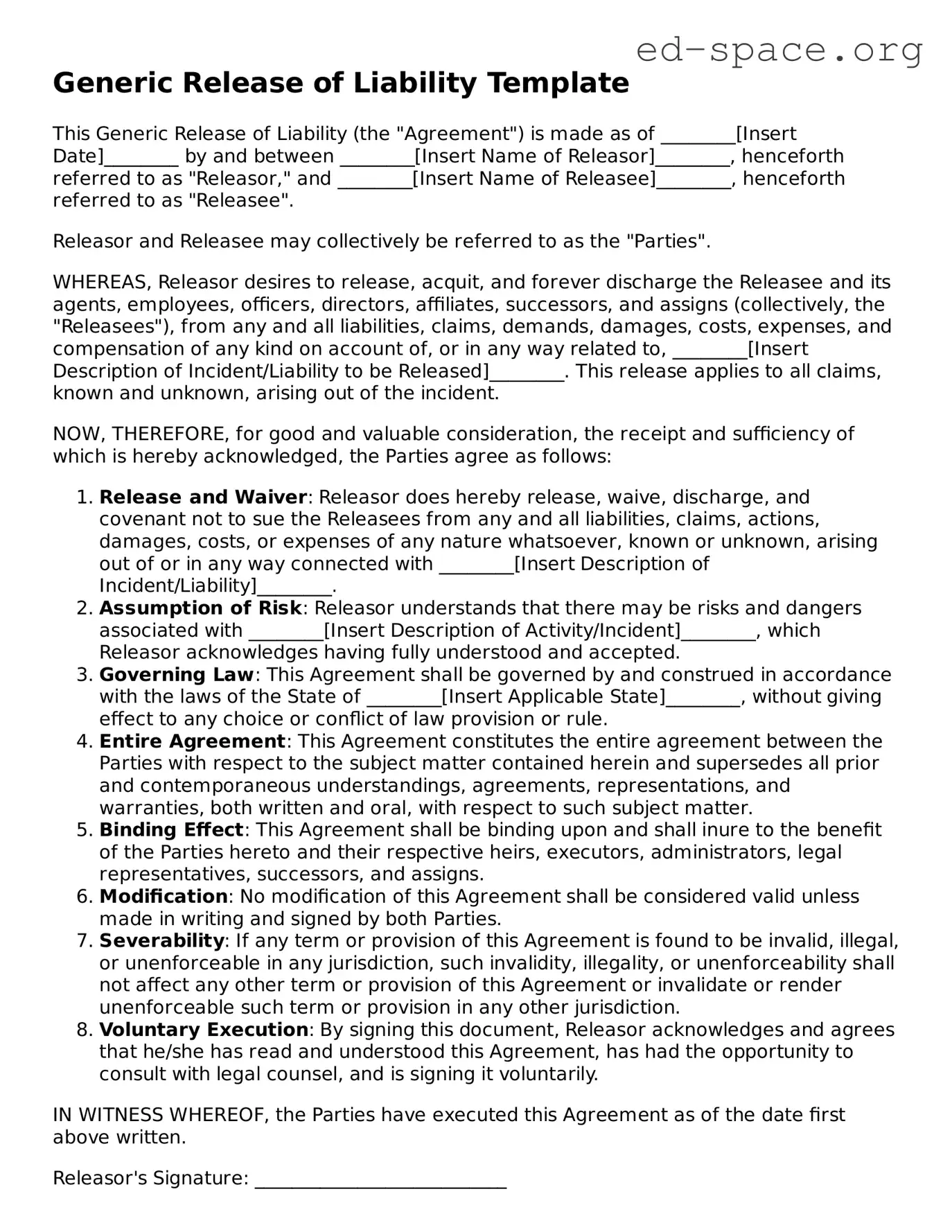Generic Release of Liability Template
This Generic Release of Liability (the "Agreement") is made as of ________[Insert Date]________ by and between ________[Insert Name of Releasor]________, henceforth referred to as "Releasor," and ________[Insert Name of Releasee]________, henceforth referred to as "Releasee".
Releasor and Releasee may collectively be referred to as the "Parties".
WHEREAS, Releasor desires to release, acquit, and forever discharge the Releasee and its agents, employees, officers, directors, affiliates, successors, and assigns (collectively, the "Releasees"), from any and all liabilities, claims, demands, damages, costs, expenses, and compensation of any kind on account of, or in any way related to, ________[Insert Description of Incident/Liability to be Released]________. This release applies to all claims, known and unknown, arising out of the incident.
NOW, THEREFORE, for good and valuable consideration, the receipt and sufficiency of which is hereby acknowledged, the Parties agree as follows:
- Release and Waiver: Releasor does hereby release, waive, discharge, and covenant not to sue the Releasees from any and all liabilities, claims, actions, damages, costs, or expenses of any nature whatsoever, known or unknown, arising out of or in any way connected with ________[Insert Description of Incident/Liability]________.
- Assumption of Risk: Releasor understands that there may be risks and dangers associated with ________[Insert Description of Activity/Incident]________, which Releasor acknowledges having fully understood and accepted.
- Governing Law: This Agreement shall be governed by and construed in accordance with the laws of the State of ________[Insert Applicable State]________, without giving effect to any choice or conflict of law provision or rule.
- Entire Agreement: This Agreement constitutes the entire agreement between the Parties with respect to the subject matter contained herein and supersedes all prior and contemporaneous understandings, agreements, representations, and warranties, both written and oral, with respect to such subject matter.
- Binding Effect: This Agreement shall be binding upon and shall inure to the benefit of the Parties hereto and their respective heirs, executors, administrators, legal representatives, successors, and assigns.
- Modification: No modification of this Agreement shall be considered valid unless made in writing and signed by both Parties.
- Severability: If any term or provision of this Agreement is found to be invalid, illegal, or unenforceable in any jurisdiction, such invalidity, illegality, or unenforceability shall not affect any other term or provision of this Agreement or invalidate or render unenforceable such term or provision in any other jurisdiction.
- Voluntary Execution: By signing this document, Releasor acknowledges and agrees that he/she has read and understood this Agreement, has had the opportunity to consult with legal counsel, and is signing it voluntarily.
IN WITNESS WHEREOF, the Parties have executed this Agreement as of the date first above written.
Releasor's Signature: ___________________________
Releasor's Printed Name: ________________________
Date: _________________________________________
Releasee's Signature: __________________________
Releasee's Printed Name: _______________________
Date: _________________________________________
